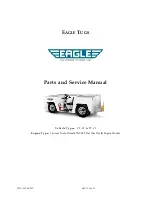
ENGINE FUEL 6M-9
Fig. H9— Choke C oil Rod Ajdustment
2. Pull down on coil rod to end of travel.
3. Bottom of rod end which slides into hole in choke
lever should be in line with the notch.
4. Bend choke coil rod at point shown to adjust to notch.
5. Connect coil rod to choke lever and install retaining
clip.
6. Ensure complete freedom of operation from full open
to full closed choke.
PRELIMINARY IDLE SPEED SCREW ADJUSTMENT
1. Hold choke valve wide open so that fast idle cam
follower clears fast idle cam.
2. Adjust idle speed screw until it just contacts the
lever tang.
3. Adjust idle speed screw an additional 1-1/4 turns
with automatic transmission and 2 turns with manual
transmission carburetors.
Fig. H I 1— Secondary Throttle Link Adjustment
C.E.C. VALVE ADJUSTMENT (Fig. H10)
This adjustment is to be made only after, (1) replace
ment of the solenoid, (2) major overhaul of the carbure
tor is performed, or (3) after the throttle body is re
moved and replaced.
CAUTION:
If the C.E.C. Solenoid on the carbu
retor is used to set engine idle or is adjusted out
of limits specified in the Service Manual, de
crease in engine braking may result.
The C.E.C. valve setting is made only after completing
instruction on tune-up sticker.
With engine running and transmission in "Neutral" for
manual and in "Drive" for automatics, with air condition
ing off, distributor vacuum hose removed and plugged,
and fuel tank hose from vapor canister disconnected,
perform the following:
1. Manually extend the C.E.C. valve plunger to contact
throttle lever.
2. Adjust plunger length to obtain idle speeds (see
"Other Adjustments" Specifications Chart at end of
this manual - Column #4).
SECONDARY THROTTLE LINK ADJUSTMENT
(Fig. H I 1)
Examine secondary throttle return link to assure slight
clearance (.015-.025) at slot end with both primary and
secondary throttle plates in closed position.
CAUTION:
A screw or stove bolt should never
be placed in the secondary lever slot to operate
the secondaries mechanically.
ALL CARBURETORS
REM OVAL (Fig. K1)
Flooding, stumble on acceleration and other perform
ance complaints are, in many instances, caused by the
presence of dirt, water, or other foreign matter in the
carburetor. To aid in diagnosing the cause of the com
plaint, the carburetor should be carefully removed from
the engine without draining the fuel from the bowl. The
contents of the fuel bowl may then be examined for con
tamination as the carburetor is disassembled.
1. Remove air cleaner and gasket.
2. Disconnect fuel and vacuum lines from carburetor.
10-30 CHEVROLET TRUCK SERVICE MANUAL
Summary of Contents for 10 1971 Series
Page 1: ......
Page 96: ......
Page 100: ...10 30 CHEVROLET TRUCK SERVICE MANUAL Fig 4 10 30 Series Truck Frame FRAME 2 4 ...
Page 120: ......
Page 203: ...ENGINE 6 25 Fig 22L Engine Mounts 10 30 CHEVROLET TRUCK SERVICE MANUAL ...
Page 215: ...ENGINE 6 37 REAR M O U NT Fig 21V Engine Mounts 10 30 CHEVROLET TRUCK SERVICE MANUAL ...
Page 218: ......
Page 249: ......
Page 324: ......
Page 340: ......
Page 365: ...10 30 CHEVROLET TRUCK SERVICE MANUAL Fig 43 Power Steering Pump M ounting STEERING 9 25 ...
Page 368: ......
Page 386: ......
Page 390: ...ELECTRICAL BODY AND CHASSIS 12 4 10 30 CHEVROLET TRUCK SERVICE MANUAL ...
Page 391: ......
Page 428: ......
Page 432: ......
Page 449: ...SPECIFICATIONS 9 10 30 CHEVROLET TRUCK SERVICE MANUAL ...
Page 463: ......
Page 464: ......
Page 465: ......
Page 466: ......




































